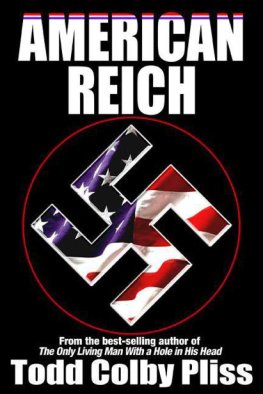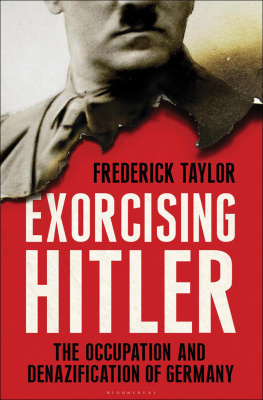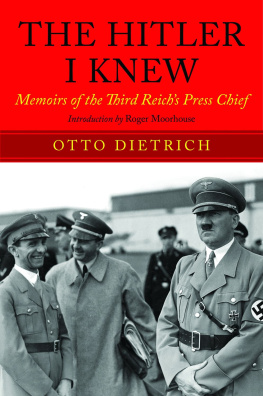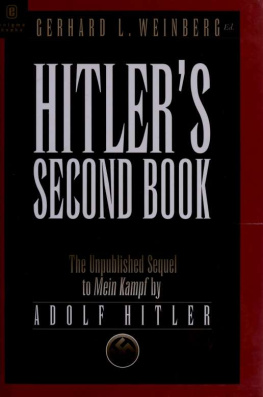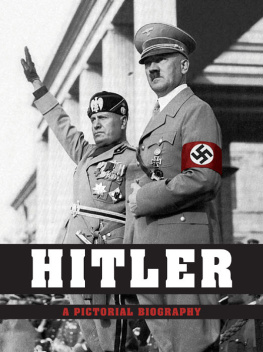Todd Colby Pliss
AMERICAN REICH
New Berlin City has had a magnificent skyline for the past forty years. It was rebuilt by the Reich Ministry for Reconstruction in the Occupied Territories where the beautiful Statue of Liberty stood on what was Liberty Island. Now, a massive statue of a well-built young man stands with his right arm extended in the Sieg Heil salute. A huge sculpture of a swastika sits at the statues base. The Reich Ministry of Interior building, once known as the Empire State Building, is lit up in the colors of the Deutschland flag: black, red, and yellow.
The city that used to be home to the most important stock markets in the world, a great center of capitalism, is now little more than ruins thanks to German bombing raids during the war. After the victors have rebuilt, the neoclassical style of the Third Reich reigns. European-styled outdoor cafs are commonplace. The automobiles parked on the streets are all Volkswagen Beetles, a car designed by Hitler himself, with the exception of a handful of Mercedes driven by important government officials. The signs are all printed in German.
On this crisp, clear spring day, a large procession of Nazi SS men dressed impeccably in full uniform and carrying brightly lit torches marched in disciplined columns to the blare of martial music. Citizens are perched on windowsills, while boys cling enthusiastically to iron fences like bunches of grapes, cheerfully waving their little swastika flags.
The procession proceeds down the Avenue of the Americas, now called Kreuzung von Neu Deutschland or the Crossroads of New Germany, toward what was once known as Times Square, but is now called Grnder Platz, Founders Square.
Adolf Hitler stands tall in the center of the square. The Fhrer is not around anymore, having died in 1965 at the age of 76, but statues such as this and his important writings like Mein Kampf have kept his spirit alive, and will continue to do so for eons to come.
Standing around the Hitler statue, packed in very tightly, are citizens of the Reich men, women, and children all very Aryan looking with their blond hair and blue eyes. Many of the men sport the always popular toothbrush mustache, as a tribute to the man who had led Germany to a height of conquests never before attained by a nation in mans short history on Earth.
There is an excitement in the air, for today is a big holiday-Victory Day. This commemorates the anniversary of the end of the war, when Germany received an unconditional surrender from her last enemy she had not yet defeated, the United States.
Victory Day is one of many national holidays that the Reich uses as an excuse to stage huge rallies, parades, sentimental speeches, and all sorts of other propagandist means to remind the German masses of their own superiority, perfect bloodlines and, since most German citizens were not even alive at the time the war took place, that how their superiority led their people to such great heights. Besides Victory Day, other national Reich holidays include Hitlers birthday (April 20), Party Day (January 30th-the day that Hitler became chancellor of Germany and thus the Nazis came to power) as well as many others.
Just as important a purpose for these national Reich holidays is to remind the slave peoples of the world (peoples of the many inferior countries whom has been allowed to live with the sole purpose of serving their Reich masters) just who is in charge. The slave peoples, including the natives not of a pure Germanic bloodline from the countries formerly known as France, Russia, Mexico, Holland, the United States, Greece, Iran, Tonga, Hungary, Poland, Canada, and Norway (just to name a few) are all required to observe these official functions. They, obviously, are banned from participating in them.
Gestapo headquarters, located in the heart of the city, is a towering structure. In front of the building, two flags hang from a flagpole. One flag is the German national flag. The other flag is the Party flag, which is comprised of the familiar red background with a large white circle in the middle and a black swastika in the white circle. Just the thought of being brought to this building is enough to instill fear into the citizens of this magnificent city.
The Gestapos importance and power has expanded significantly since the end of the war. This organization of secret state police is considered necessary to protect the existence of the Reich by tracking down and doing away with all complainers, dissenters, and opponents. It is official Gestapo policy that any individual, no matter what his status, is a potential suspect. In 1991, a top Gestapo official, Hans Sber, was accused of allegedly harboring anti-party feelings when he was overheard on the phone telling his wife that all the official functions and dinners he was obligated to attend on a regular basis were tiring him out. After a quick trial in the Volksgericht, the court was set up to render quick verdicts for accused traitors of the Third Reich. Sber was publicly hanged; his four young children were forced to watch.
A two-foot thick, steel entrance door opened to the cellblock. The prisoner, Wayne Goldberg, a young man with black hair and brown eyes, was dragged in by five guards. Blood is caked in Waynes hair and stains his torn rags. SS Captain Siegfried von Helldorf stepped in behind everyone.
Captain von Helldorf, a middle-aged mole-like man, nodded to one of his men, Open the door.
The cell stands empty except for one other prisoner cowering warily at the back; theres not even a toilet. A guard shoved Wayne into the cell and locked it behind him.
Helldorf, stared menacingly at Wayne, See you at your execution, my friend. He laughed and then left with his men.
Wayne leaned his hurting body heavily against the concrete wall and spit out a mouthful of blood.
Wheres the toilet in this God forsaken rat hole? he asked wearily.
The other prisoner pointed down, Youre standing in it. Wayne looked down at his feet to see a puddle of urine.
In Grunder Platz was bubbling with a festive atmosphere. National German music played as children danced and ate cotton candy below the fluttering swastikas. The New Berlin branch of the Hitler Jugend was present. They were all dressed in their uniforms of black shoes, black ties, and swastika armbands. Behind them, the League of German Girls stood smiling in their matching dresses. When a child turns ten, they are required to register with the Reich Youth Headquarters. The Hitler Youth was exclusively for boys. The membership of the organization for girls, the League of German Girls, was also present, though its membership was not nearly as big as that of the Hitler Youth.
A speakers podium had been set up near a massive television screen. Reich Marshal Ulrich, a balding, heavyset man of about fifty stood at the podium with prominent Reich leaders, Gauleiters and, SS Security men behind him.
Reich Marshal Ulrich addressed the massive crowd, Now, citizens of New Berlin City and of all the German Unified Territories, it is an honor for me to present to you live from Berlin our Fhrer! The crowd reacted wildly, chanting, Seig Heil and raising their arms in salute.
On the big screen appeared Fhrer Karl Gring. He resembled his late father, Hermann Wilhelm Gring, who was Hitlers second-in-command and the high military and economic leader before he came to power after Hitlers death. Karl Gring was obese, loud, and had a full head of salt and pepper hair. He had inherited an overindulgence for the finer things in life. Gring had the most valuable art collection in the world, as well as the largest wine collection, not to mention his vast private hunting preserves around the planet.
Gring raised his right arm. The masses responded enthusiastically,

